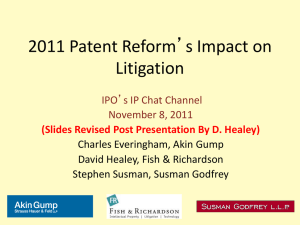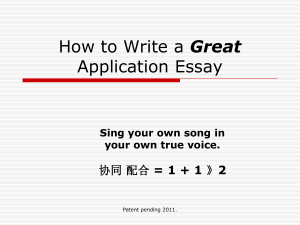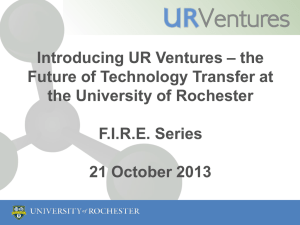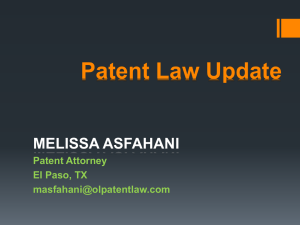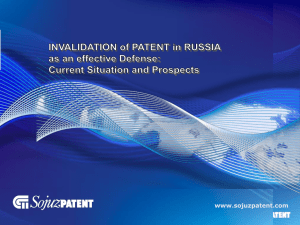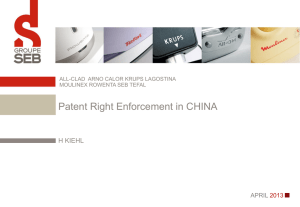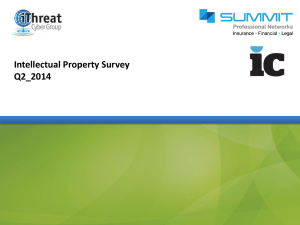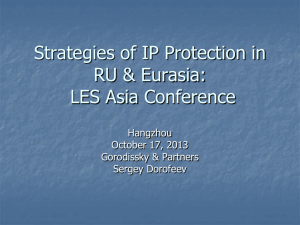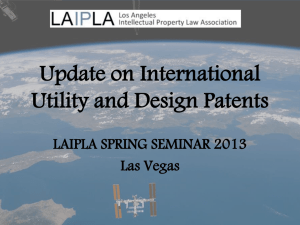Patent Litigation Overview
advertisement
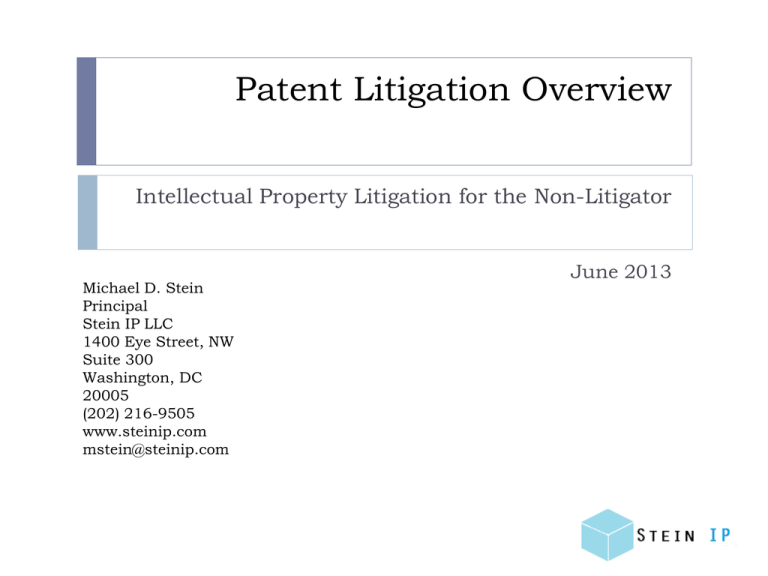
Patent Litigation Overview Intellectual Property Litigation for the Non-Litigator Michael D. Stein Principal Stein IP LLC 1400 Eye Street, NW Suite 300 Washington, DC 20005 (202) 216-9505 www.steinip.com mstein@steinip.com June 2013 Table of Contents Overview .................................................................................................................... Pre-filing Considerations ………….............................................................................. Suit Attacking Intellectual Property ............................................................................. Filing the Suit.............................................................................................................. Responding to the Complaint...................................................................................... Other Procedural and Pretrial Issues ......................................................................... Remedies.................................................................................................................... 1 2 3 16 18 20 21 28 Overview Pre-Filing Considerations Suit Attacking IP Filing the Suit Responding to the Complaint Remedies 2 Pre-filing Considerations Patent: Issued U.S. Patent. Can only sue in federal court to stop infringement, seek damages, or seek a declaration on non-infringement/invalidity 3 Cannot sue until issues Can recover damages (possibly) for preissue publication, but only when issues Also USPTO proceedings for invalidity Also ITC for purely injunctions Pre-filing Considerations (cont.) Cost Considerations Need to do a cost/benefit analysis What are expected litigation costs for litigation versus expected remedies and outcome. AIPLA Report of the Economy Survey 2011 Median costs with $1 million to $25 million at risk: Median costs with $25 million or more at risk: 4 to end of discovery: $1.5 million; to judgment: $2.5 million total. to end of discovery: $3 million; to judgment: $5 million total. Pre-filing Considerations (cont.) Pre-filing investigations for infringement How much investigation is enough? Whatever is reasonable under the circumstances 5 Is reverse engineering possible? What is available publically? See Performing A Pre-Filing Investigation When Samples Are Not Available Pre-filing Considerations (cont.) Pre-filing investigations need to account for invalidity issues Especially since attempting to enforce patents known to be invalid can be an antitrust violation Walker Process Equipment Inc. v. Food Machinery and Chemical Corp., 382 U.S. 172 (1965) Patent owner had sworn to the patent office that the claimed invention had not been in public use 6 The patent owner had known this was false at the time. Patent owner sued to enforce the resulting patent, Supreme Court found that, by knowing of the fraud and attempting to enforce the invalid patent, the patent owner was violating the Sherman and Clayton Acts. Worse than Rule 11 sanctions Pre-filing Considerations (cont.) Strength, Weakness of Patent Case 7 Closeness of infringement? Literal and/or doctrine of equivalents arguments available? If doctrine of equivalents is to be argued, must consider “Prosecution History Estoppel” issues per Hilton Davis and Festo. Past enforcement activities of patentee? Are there licensees? Have the claims been challenged in court, in reexamination, in foreign opposition/litigation? Press Releases, Internet searching (e.g., chat rooms) can provide information. Importance of patent to patentee’s business plan? Importance of allegedly infringing product/process to alleged infringer? Closeness of prior art? Hypothetical claim analysis? Applicable law? Generally rather consistent since the Court of Appeals for the Federal Circuit (“CAFC”) started, so no longer have differing Circuit Court law. Has any new prior patent or publication been recently discovered which raises a substantial new question of patentability of any claim? Consider filing a re-examination request. Is there any defect in the patent, which arose without any deceptive intent? Consider filing a reissue request. (see problem in Chef America Inc. v. Lamb-Weston, Inc) Are patentee’s maintenance fees paid? Pre-filing Considerations (cont.) Seek Temporary Restraining Order (“TRO”) or Preliminary Injunction? Court balances: 8 No longer easy to get likelihood that plaintiff will have reasonable success on the merits; “irreparable harm”, i.e., the plaintiff does not have an adequate remedy at law (i.e., money alone won’t solve problem); the threat of injury to plaintiff outweighs any damage to defendant that would be caused by injunction; and granting the preliminary injunction will not be contrary to the public interest. See FRCP 65. Pre-filing Considerations (cont.) Timing: Aggressive timetable, e.g., "rocket docket" (E.D.Va., E. D. Tx), serving discovery immediately and working for preliminary injunction immediately, or a more controlled pace. Jury demand? Either party can request. Pros and Cons (e.g., Sympathetic party or local party). 9 If a jury, need a Markman hearing. Pre-filing Considerations (cont.) Alternate Proceedings? Send a cease and desist letter and perhaps offer a license. Be careful as any letter can be grounds for Declaratory Judgment. For patents, file for reissue or reexamination to correct errors in patent or to address new prior art, respectively, which can strengthen patentee’s case. Bring an action in the International Trade Commission (“ITC”) first or in addition to a federal district court action. See discussion of ITC proceedings below. Seek mediation/arbitration? Binding or non-binding? 10 Pre-filing Considerations (cont.) Related Rights and Countersuits Search for other patents of opponent. Has any related patent been litigated/licensed? What prior art was cited therein and was it cited in the subject patent? Search for ownership issues for asserted patent Does the plaintiff actually own the patent? 11 E.g., Bd. of Trs. of Leland Stanford Junior Univer. v. Roche Molecular Sys., Inc., 583 F.3d 832 (Fed. Cir. 2009), aff ’d, 131 S. Ct. 2188 (2011) (Plaintiff sued Defendant only to discover Defendant was equitable owner) Pre-filing Considerations (cont.) Who Is Subject to Patent Suit? 35 U.S.C. Section 271: 12 Direct Infringers - anyone who makes, uses, sells, offers to sell or imports into the U.S (e.g., manufacturer, wholesaler, retailer, customers/users) Inducing Infringer (e.g., knowingly gives instructions on how to infringe) Contributory Infringer (e.g., knowingly makes components which, when used with other components, infringe, and otherwise are not capable of substantial non-infringing uses) Pre-filing Considerations (cont.) Choosing forum can be complex Personal jurisdiction: Is it fair to sue Subject matter jurisdiction – what is the right court For patents, any Federal Court (28 U.S.C. § 1338) State court deals with contractual agreements regarding patents, e.g., assignments/licenses Venue – where is convenient 13 - due process - must be able to give fair notice of suit. May need to look to “substantial contacts” between out-of-state corporation and the state in which the federal district court sits. 28 U.S.C. § 1400 (1) where defendant resides (corporation resides where incorporated) or (2) committed infringing act and has a regular and established place of business Pre-filing Considerations (cont.) Limitations Statute of Limitations: 14 Patents - 6 years for damages – 35 U.S.C. Section 286 Laches - Wait too long? Estoppel (e.g., agreement reached w/Defendant's predecessor, implied license, etc.) Pre-filing Considerations (cont.) Who Will Represent You? Should the firm that prosecuted the patent handle the suit dealing with the patent? Positives: Know technology Problem: Inequitable conduct is standard defense 15 Prosecuting attorney may be a fact witness at trial Can lead to disqualification of entire firm. E.g., Crossroads Systems (Texas) Inc. v. Dot Hill Systems Corp, 82 USPQ2d 1517 (W.D. Tex. 2006) (firm which did opinion work for party disqualified due to conflict of interest) Suit Attacking Intellectual Property The Declaratory Judgment Act, 28 USC § 2201 16 Who can maintain Suit? Anyone “threatened”. Usually, a party accused of patent infringement may bring a DJ action against the patent holder prior to being sued for infringement (thereby selecting the venue for the lawsuit). Conversely, the defendant in a patent infringement that has already been filed will often bring DJ counterclaims of non-infringement, invalidity and unenforceability of the patent. Suit Attacking Intellectual Property (cont.) Where can suit be filed? Need Personal and Subject Mater Jurisdiction Venue - where all defendants reside or where claim arose When can suit be filed? There must be an actual or implicit charge of infringement and the actual controversy must be present before the DJ action is ripe for adjudication. To establish the existence of a case of actual controversy between the parties: (1) (2) Low standard after MedImmune Inc. v. Genentech Inc., 81 USPQ2d 1225 (2007) 17 the defendant must have engaged in conduct giving rise to a reasonable apprehension on plaintiff’s part that it will face an infringement suit or the threat of one if it commences or continues the activity in question, and the plaintiff must have actually produced the accused device or have actually prepared to produce it. The threat of serious business injury presented a sufficient controversy for Article III jurisdiction Filing the Suit Preparing the Complaint – Form 16 of FRCP Jurisdictional Statement Statement of the Claim(s) Patent: Exhibits? 18 By the patentee: patent is infringed By the accused infringer: patent is being used by patentee to threaten and accused infringer needs declaration of invalidity / non-infringement / unenforceability Copy of patent registration, Certificate of correction Threatening letter Filing the Suit (cont.) Joinder of Required Parties – FRCP 19 Patent owner must be joined 19 Tricky where licensee enforcing patent Responding to the Complaint “Answer” In General Manner of Response “admit” or “deny” or “lack sufficient information” Must be cautious since fraudulent denials subject to Rule 11 Sanctions Affirmative defenses (e.g., invalidity by fraud, prior art, noninfringement, etc.) Counterclaims By the accused Infringer E.g., misuse, antitrust, infringement of a patent of defendant) By the patentee in a declaratory Judgment action – 20 Can also admit in part and deny in part if allegation only partially true infringement of the patentee’s patent. Other Procedural and Pretrial Issues Matters Respecting the Forum Motion for Transfer - Change of Venue Motion for Stay: E.g., Defendant filed for reexamination of the patent, so defer the court case until the PTO has decided reexamination. Plaintiff filed a Section 337 proceeding at the ITC, so stay the federal court action until issues are determined in the ITC? Motion to Consolidate: Defendant already filed a separate action for DJ in another jurisdiction. Plaintiff sued other defendants on same patent recently in another forum. Combine these related cases? Move for Temporary Restraining Order/Preliminary Injunction 21 Other Procedural and Pretrial Issues (cont.) Expert Witnesses? Will one be needed? Regarding the technology of the patent? Regarding patent or trademark law? Regarding a survey on "niche" market for dilution fame? Regarding damages (economist), etc? Can increase costs significantly and raise tough questions regarding discovery. Considerations in IP litigation Whether an expert that you hired who prepared an opinion, but was later replaced by another expert, must have the opinion disclosed? Need to prepare an Expert’s report early on. FRCP 26. 22 The court may appoint its own expert if it believes that would be helpful, but this is rare. Other Procedural and Pretrial Issues (cont.) Markman Hearing - With Jury Trial Only Timing Judge defines claim terms prior to going to the jury. 23 An objective test of what one of ordinary skill in the art at the time of the invention would have understood the term to be. Judge tells jury what claims mean, and jury tells Judge if there is infringement Court may at first limit discovery to claim interpretation issues only, since the issue may be dispositive of the case. Other Procedural and Pretrial Issues (cont.) The infringer briefs those terms which it believes are indefinite, etc., Relies on the specification, statements made by applicant during prosecution about the prior art as it relates to the claims, dictionary definitions, etc. Defendant tries to raise as many terms as possible as being indefinite. The patentee provides its own brief arguing that the terms are not indefinite and/or arguing the meaning of the terms. The court usually has a hearing (no jury) in which these terms are discussed, perhaps with the help of experts, and the judge renders a written decision with supporting analysis on what the terms mean. 24 The patentee seeks an interpretation that preserves the validity of the claims over the prior art and that would likely lead to a finding that the defendant has infringed, preferably literally, but at least under the doctrine of equivalents. The alleged infringer wants an interpretation that leads to either non-validity or noninfringement. Other Procedural and Pretrial Issues (cont.) Result of hearing often leads to settlement or disposition of the case on summary judgment regarding infringement. Claim interpretation is subject to de novo review on appeal. 25 Depending upon which party the claim interpretation is favorable to, may promote move of one party for summary judgment If favorable to neither party, may promote settlement The standard appellate review is error, not clear error. Other Procedural and Pretrial Issues (cont.) Discovery Both sides are permitted to 26 Request documents of other side that are not privileged Request responses to interrogatories for information that is not privileged Depose people with knowledge of business or technical issues related to the suit Consult with experts who are not related to either party on issues relating to the suit, such as economic issues, technical issues Other Procedural and Pretrial Issues (cont.) If the case goes to trial, the judge advises the jury of the claim interpretation in the “jury instructions” just before the jury retires from the courtroom to deliberate 27 Remedies Determination of the Award Patent: Injunction. 35 U.S.C. § 283 Exceptional case 28 Actual Damages not less than reasonable royalties (established or hypothetical?). Can be tripled if there has been willful infringement, and can include interest and costs. 35 U.S.C. § 284. Damages do not begin to accrue until patent “notice” (i.e., marking) used, alleged infringer notified in writing or suit brought. 35 U.S.C. § 287. Attorneys’ fees. E.g., alleged infringer obtained opinion that there was a high risk of infringement, but did not even attempt to design around, written notice of infringement sent, and alleged infringer was obstructionist during discovery and trial). 35 U.S.C. § 285.
